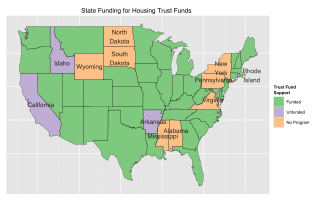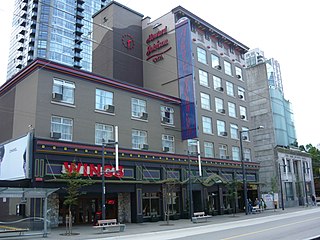Related Research Articles

In urban planning, zoning is a method in which a municipality or other tier of government divides land into "zones", each of which has a set of regulations for new development that differs from other zones. Zones may be defined for a single use, they may combine several compatible activities by use, or in the case of form-based zoning, the differing regulations may govern the density, size and shape of allowed buildings whatever their use. The planning rules for each zone determine whether planning permission for a given development may be granted. Zoning may specify a variety of outright and conditional uses of land. It may indicate the size and dimensions of lots that land may be subdivided into, or the form and scale of buildings. These guidelines are set in order to guide urban growth and development.
The Comprehensive Permit Act is a Massachusetts law which allows developers of affordable housing to override certain aspects of municipal zoning bylaws and other requirements. It consists of Massachusetts General Laws (M.G.L.) Chapter 40B, Sections 20 through 23, along with associated regulations issued and administered by the Massachusetts Department of Housing and Community Development. Chapter 40B was enacted in 1969 to address the shortage of affordable housing statewide by reducing barriers created by local municipal building permit approval processes, local zoning, and other restrictions. Its goal is to encourage the production of affordable housing in all communities throughout the Commonwealth.

Affordable housing is housing which is deemed affordable to those with a household income at or below the median as rated by the national government or a local government by a recognized housing affordability index. Most of the literature on affordable housing refers to mortgages and a number of forms that exist along a continuum – from emergency homeless shelters, to transitional housing, to non-market rental, to formal and informal rental, indigenous housing, and ending with affordable home ownership.
The Mount Laurel doctrine is a significant judicial doctrine of the New Jersey State Constitution. The doctrine requires that municipalities use their zoning powers in an affirmative manner to provide a realistic opportunity for the production of housing affordable to low- and moderate-income households.

Workforce housing is a term that is increasingly used by planners, government, and organizations concerned with housing policy or advocacy. It is gaining cachet with realtors, developers and lenders. Workforce housing can refer to any form of housing, including ownership of single or multi-family homes, as well as occupation of rental units. Workforce housing is generally understood to mean affordable housing for households with earned income that is insufficient to secure quality housing in reasonable proximity to the workplace.

Secondary suites (also known as accessory dwelling units (ADU), in-law apartments, granny flats, granny annexes or garden suites) are self-contained apartments, cottages, or small residential units, that are located on a property that has a separate main, single-family home, duplex, or other residential unit. In some cases, the ADU or in-law is attached to the principal dwelling or is an entirely separate unit, located above a garage, across a carport, or in the backyard on the same property. Reasons for wanting to add a secondary suite to a property may be to receive additional income, provide social and personal support to a family member, or obtain greater security.

In the United States, subsidized housing is administered by federal, state and local agencies to provide subsidized rental assistance for low-income households. Public housing is priced much below the market rate, allowing people to live in more convenient locations rather than move away from the city in search of lower rents. In most federally-funded rental assistance programs, the tenants' monthly rent is set at 30% of their household income. Now increasingly provided in a variety of settings and formats, originally public housing in the U.S. consisted primarily of one or more concentrated blocks of low-rise and/or high-rise apartment buildings. These complexes are operated by state and local housing authorities which are authorized and funded by the United States Department of Housing and Urban Development (HUD). In 2020, there were one million public housing units. In 2022, about 5.2 million American households that received some form of federal rental assistance.
Exclusionary zoning is the use of zoning ordinances to exclude certain types of land uses from a given community, especially to regulate racial and economic diversity. In the United States, exclusionary zoning ordinances are standard in almost all communities. Exclusionary zoning was introduced in the early 1900s, typically to prevent racial and ethnic minorities from moving into middle- and upper-class neighborhoods. Municipalities use zoning to limit the supply of available housing units, such as by prohibiting multi-family residential dwellings or setting minimum lot size requirements. These ordinances raise costs, making it less likely that lower-income groups will move in. Development fees for variance, a building permit, a certificate of occupancy, a filing (legal) cost, special permits and planned-unit development applications for new housing also raise prices to levels inaccessible for lower income people.
Housing discrimination in the United States refers to the historical and current barriers, policies, and biases that prevent equitable access to housing. Housing discrimination became more pronounced after the abolition of slavery in 1865, typically as part of Jim Crow laws that enforced racial segregation. The federal government didn't begin to take action against these laws until 1917, when the Supreme Court struck down ordinances prohibiting blacks from occupying or owning buildings in majority-white neighborhoods in Buchanan v. Warley. However, the federal government as well as local governments continued to be directly responsible for housing discrimination through redlining and race-restricted covenants until the Civil Rights Act of 1968.

Housing trust funds are established sources of funding for affordable housing construction and other related purposes created by governments in the United States (U.S.). Housing Trust Funds (HTF) began as a way of funding affordable housing in the late 1970s. Since then, elected government officials from all levels of government in the U.S. have established housing trust funds to support the construction, acquisition, and preservation of affordable housing and related services to meet the housing needs of low-income households. Ideally, HTFs are funded through dedicated revenues like real estate transfer taxes or document recording fees to ensure a steady stream of funding rather than being dependent on regular budget processes. As of 2016, 400 state, local and county trust funds existed across the U.S.

The definition of mixed-income housing is broad and encompasses many types of dwellings and neighborhoods. Following Brophy and Smith, the following will discuss “non-organic” examples of mixed-income housing, meaning “a deliberate effort to construct and/or own a multifamily development that has the mixing of income groups as a fundamental part of its financial and operating plans” A new, constructed mixed-income housing development includes diverse types of housing units, such as apartments, town homes, and/or single-family homes for people with a range of income levels. Mixed-income housing may include housing that is priced based on the dominant housing market with only a few units priced for lower-income residents, or it may not include any market-rate units and be built exclusively for low- and moderate-income residents. Calculating Area Median Income (AMI) and pricing units at certain percentages of AMI most often determine the income mix of a mixed-income housing development. Mixed-income housing is one of two primary mechanisms to eliminate neighborhoods of concentrated poverty, combat residential segregation, and avoid the building of public housing that offers 100% of its housing units to those living in poverty. Mixed-income housing is built through federal-, state-, and local-level efforts and through a combination of public-private-non-profit partnerships.

Affordable housing in Canada is living spaces that are deemed financially accessible to those with a median household income in Canada. The property ladder continuum of affordable housing in Canada includes market, non-market, and government-subsidized housing.

Howard County Housing is the umbrella organization for the Howard County Department of Housing and Community Development and the Howard County Housing Commission. The Department is Howard County Government’s housing agency, and the Commission is a public housing authority and non-profit. Both have boards that meet monthly.

A "poor door" is a separate entrance to a multi-unit housing development for those living in less expensive apartments.
The Costa–Hawkins Rental Housing Act ("Costa–Hawkins") is a California state law, enacted in 1995, which places limits on municipal rent control ordinances. Costa–Hawkins preempts the field in two major ways. First, it prohibits cities from establishing rent control over certain kinds of residential units, e.g., single-family dwellings and condominiums, and newly constructed apartment units; these are deemed exempt. Second, it prohibits "vacancy control", also called "strict" rent control. The legislation was sponsored by Democratic Senator Jim Costa and Republican Assemblymember Phil Hawkins.

Since about 1970, California has been experiencing an extended and increasing housing shortage, such that by 2018, California ranked 49th among the states of the U.S. in terms of housing units per resident. This shortage has been estimated to be 3-4 million housing units as of 2017. Experts say that California needs to double its current rate of housing production to keep up with expected population growth and prevent prices from further increasing, and needs to quadruple the current rate of housing production over the next seven years in order for prices and rents to decline.

Affordable housing is housing that is deemed affordable to those with a median household income as rated by the national government or a local government by a recognized housing affordability index. A general rule is no more than 30% of gross monthly income should be spent on housing, to be considered affordable as the challenges of promoting affordable housing varies by location.
Silicon Valley, a region located in the southern part of the San Francisco Bay Area, is one of the most expensive regions to live in the United States, and many residents lack access to affordable housing. In 2018, the median home price across the area was $1.18 million, the highest of the 100 largest metro areas in the U.S. The growth of the technology industry in the area, including major companies like Google, Facebook, and Apple, is frequently cited as a major cause of the issue. There have been local efforts to address affordable housing, as well as state measures in response to housing issues across California.
Climate gentrification is a subset of climate migration, in which certain lower-socioeconomic communities are displaced in place of housing for more wealthy communities. Areas affected by this phenomenon are typically coastal cities, islands, and other vulnerable areas that are susceptible to rising sea levels, extreme weather events, and other climate-related disasters.
The term "affordable housing" refers to housing that is considered economically accessible for individuals and families whose household income falls at or below the Area Median Income (AMI), as evaluated by either national or local government authorities through an officially recognized housing affordability index. However, in the US, the term is mostly used to refer to housing units that are deed restricted to households considered Low-Income, Very Low-Income, and Extremely Low-Income. These units are most often constructed by non-profit "affordable housing developers" who use a combination of private money and government subsidies. For-profit developers, when building market-rate developments, may include some "affordable" units, if required as part of a city's inclusionary zoning mandate.
References
- Business and Professional People for the Public Interest Issue Brief #4 Inclusionary Housing in Montgomery County, MD,
- Rusk, David; Nine Lessons for Inclusionary Zoning, National Inclusionary Housing Conference
- Waring, Tom; "Section 8 needs a dose of reform, Hoeffel says" Northeast Times , May 15, 2002
- Inclusionary Housing for the City of Chicago: Facts and Myths, North Park University